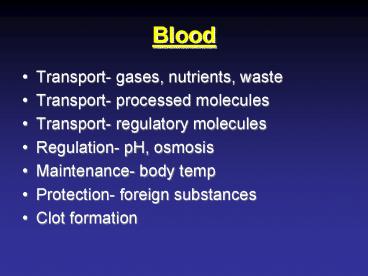Blood - PowerPoint PPT Presentation
1 / 29
Title:
Blood
Description:
Fetus- liver, thymus gland, spleen, lymph nodes, red bone marrow ... Bendable- easy to get through small capillaries. No nuclei- lost during development ... – PowerPoint PPT presentation
Number of Views:75
Avg rating:3.0/5.0
Title: Blood
1
Blood
- Transport- gases, nutrients, waste
- Transport- processed molecules
- Transport- regulatory molecules
- Regulation- pH, osmosis
- Maintenance- body temp
- Protection- foreign substances
- Clot formation
2
(No Transcript)
3
Hematopoiesis
- Process of blood cell formation
- Fetus- liver, thymus gland, spleen, lymph
nodes, red bone marrow - After birth- red bone marrow, lymph tissues
- All formed elements derived from stem cell
- Stem cells give rise to cell lines
- Development of cell lines regulated by growth
factors
4
Fig. 11.2
5
Red Blood Cells
- Disk-shaped
- Bi-concave- greater surface area
- Bendable- easy to get through small capillaries
- No nuclei- lost during development
- Hemoglobin- main component- responsible for red
color
6
Fig. 11.3
7
RBC Function
- Transport oxygen and carbon dioxide
- Hemoglobin- 4 protein chains, 4 heme groups
- Heme- has an iron molecule
- Oxygen binds to iron
- Bright red blood- oxygenated
- Dark blood- deoxygenated
- 98.5 oxygen transported by Hb
8
http//www.bio.davidson.edu/Courses/Molbio/MolStud
ents/spring2005/Heiner/hemoglobin.html
9
RBC Function
- Two thirds of iron are found in blood
- Women need to replace more iron due to
menstruation - Carbon dioxide transport- hemoglobin,
bicarbonate, plasma - 23 attached to Hb
- 7 dissolved in plasma
10
Bicarbonate
- 70 bound to bicarbonate
- Carbonic anhydrase coverts water and carbon
dioxide to H and bicarbonate - CO2 H2O ? H HCO3-
11
Life History of RBC
- 2.5 million destroyed per second
- 2.5 million made per second
- Stem cells form proerythroblasts which give rise
to cell line - Each step in transformation brings cell closer to
a mature blood cell - Stimulated by low blood oxygen
- Increase erythropoietin production by kidneys
12
Fig. 11.4
13
Life History of RBC
- Removed by macrophages in spleen and liver
- Globin broken down to amino acids
- Iron transported to red bone marrow
- Heme- bilirubin and taken up by liver
- Bilirubin- yellow pigment, normal part of bile,
malfunction results in jaundice - Bilirubin converted in intestine, gives feces its
brown color
14
Fig. 11.5
15
White Blood Cells
- Leukocytes- spherical, lack Hb, large, nucleated
- Blood is used to transport leukocytes
- Leukocytes can move by ameboid movement
- 2 functions
- Protect
- Remove dead cells, debris
16
White Blood Cells
- Named according to their appearance
- Granulocytes- large cytoplasmic granules
- Neutrophils - most abundant, phagocytize
- Basophils - least common, increase inflammation
and reduce blood clotting - Eosinophils reduce inflammation, attack worms
- Agranulocytes- small granules
- Lymphocytes immune system, produce antibodies
- Monocytes one of the largest, macrophages,
activate lymphocyctes
17
Platelets
- Thrombocytes
- Cell fragments- membrane w/ cytoplasm
- Produced in red bone marrow by megakaryocytes
- Prevent blood loss 2 ways
- Formation of plugs
- Formation of clots
18
Preventing Blood Loss
- Too much blood loss death
- 3 ways to prevent
- Vascular spasm
- Platelet plugs
- Blood clot
19
Vascular Spasm
- Immediate, temporary constriction of blood vessel
- Closes vessel, prevents blood flow
- Produced via nervous system reflexes and chemicals
20
Platelet Plugs
- Accumulation of platelets seal small break in
vessel - Small tears occur daily- maintain integrity of
circulatory system - Series of steps- happens at same time
21
Platelet Plugs
- Platelet adhesion- platelets stick to exposed
collagen - - von Willebrands factor- protein released
by blood vessel, bonds platelets to collagen - Platelet release reaction- activated platelets
change shape, release chem. - - chem. activate other platelets which
express fibrinogen receptors - Platelet aggregation- fibrinogen forms bridges
between fibrinogen receptors of other platelets
22
(No Transcript)
23
Blood Clotting
- Clot- network of fibrin, which traps blood cells,
platelets and fluid - Formation depends upon clotting factors
- Normally they are inactive
- 3 steps to clot formation
24
Clot Formation
- Two ways to start- clotting factor contacts
connective tissue - Thromboplastin- released from injured cells
- Series of clotting factors until prothrombinase
is formed - Prothrombinase converts prothrombin to thrombin
- Thrombin converts fibrinogen to fibrin
- Fibrin CLOT
25
Fig. 11.9
26
Control of clots
- No control 1 big clot
- Anticoagulants- prevent clotting factors from
forming clots - Antithrombin and heparin- inactivate thrombin
- Away from injury site, anticoagulants prevent
spread of clot
27
Clot retraction
- Condensing of clot into smaller structure
- Platelets contain ACTIN and MYOSIN
- Platelets form small extensions that attach to
fibrin - Contraction of extensions contracts clot
- Serum (plasma w/ no clotting factors) is squeezed
out - Reduces flow of blood to area
28
Fibrinolysis
- Dissolving of clots
- Plasminogen is converted to plasmin
- Stimulated by thrombin, other clotting factors
and tissue plasminogen activator (t-PA) - Plasmin dissolves fibrin over a few days
29
Fig. 11.10































